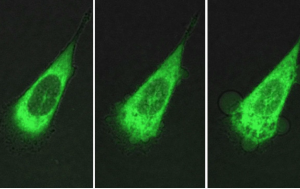In present day, when one develops cancer, the most common technology or treatment for these diseases are radiation therapy, chemotherapy, immunotherapy, targeted therapy, etc. More recently, a new way of destroying cancer cells have been discovered by researchers at Durham (UK), North Carolina State and Rice University; a group led by Professor James Tour.
Professor Tour and his team have previously worked on and created nanomachines such as motor-bearing molecules and peptide-carrying nanomachines designed to target specific cells. These studies have been previously published in Nature.
“We thought it might be possible to attach these nanomachines to the cell membrane, and then turn them on to see what happened,” said Tour. This resulted in developing these tiny, light-activating nanomachines that can target specific cells and drill through their membrane, activating apoptosis of the cell.
“These nanomachines are so tiny that 50,000 of them put together is still about the diameter of a single strand of hair,” says Tour.
Each nanomachines has a car shape, with four wheels that are motorized which allows for propulsion along cell surfaces. They are designed to target a cell’s lipid bilayer membrane. Once reaching the membrane, the nanomachine will either deliver drugs to kill the cell or the nanomachine itself will activate the cell to be destroyed.
Because this is using a molecular mechanical action and is not a biological creation, it is very unlikely for a cancer cell to develop resistance to these motorized machines. This is a great development in producing new drugs that can prevent the targeted bacteria or viruses from developing resistance and growing stronger.
These nanomachine motors were tested on live cells, including human prostate cancer cells. Experiments have shown that without an UV light trigger, the motors could still locate the specific cells of interest, but stayed on the targeted cells’ surface and were unable to drill into the cells. However, when triggered with UV light, the motors rapidly drilled through the membranes.
“Once developed, this approach could provide a potential step change in non-invasive cancer treatment and greatly improve survival rates and patient welfare globally,” said Dr. Robert Pal from Durham University, that collaborated with James Tour.
So perhaps in another 20-30 years, these nanomachines will be widely used in cancer treatment, and may possibly decrease the death rate from cancer. A very interesting idea to think about.

(Video: James Tour Explains Nanomachines at Rice University)
– Ziyi Wang


